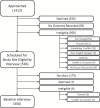Geriatric Conditions in a Population-Based Sample of Older Homeless Adults
- PMID: 26920935
- PMCID: PMC5881727
- DOI: 10.1093/geront/gnw011
Geriatric Conditions in a Population-Based Sample of Older Homeless Adults
Abstract
Purpose of the study: Older homeless adults living in shelters have high rates of geriatric conditions, which may increase their risk for acute care use and nursing home placement. However, a minority of homeless adults stay in shelters and the prevalence of geriatric conditions among homeless adults living in other environments is unknown. We determined the prevalence of common geriatric conditions in a cohort of older homeless adults, and whether the prevalence of these conditions differs across living environments.
Design and methods: We interviewed 350 homeless adults, aged 50 and older, recruited via population-based sampling in Oakland, CA. We evaluated participants for common geriatric conditions. We assessed living environment using a 6-month follow-back residential calendar, and used cluster analysis to identify participants' primary living environment over the prior 6 months.
Results: Participants stayed in 4 primary environments: unsheltered locations (n = 162), multiple locations including shelters and hotels (n = 88), intermittently with family/friends (n = 57), and, in a recently homeless group, rental housing (n = 43). Overall, 38.9% of participants reported difficulty performing 1 or more activities of daily living, 33.7% reported any falls in the past 6 months, 25.8% had cognitive impairment, 45.1% had vision impairment, and 48.0% screened positive for urinary incontinence. The prevalence of geriatric conditions did not differ significantly across living environments.
Implications: Geriatric conditions were common among older homeless adults living in diverse environments, and the prevalence of these conditions was higher than that seen in housed adults 20 years older. Services that address geriatric conditions are needed for older homeless adults living across varied environments.
Keywords: Cognitive impairment; Epidemiology; Functional status; Homeless persons; Sensory impairment.
Published by Oxford University Press on behalf of the Gerontological Society of America 2016.
Figures

Comment in
-
Re: Geriatric Conditions in a Population-Based Sample of Older Homeless Adults.J Urol. 2017 Sep;198(3):461-462. doi: 10.1016/j.juro.2017.06.058. Epub 2017 Jun 20. J Urol. 2017. PMID: 28817875 No abstract available.
References
-
- Al-Delaimy W. K. Edland S. Pierce J. P. Mills A. L., & White M. M (2011). California Tobacco Survey (CTS): 2008. California Department of Health Services. California Department of Health Services. Retrieved from http://www.cdph.ca.gov/programs/tobacco/Documents/CTCPCaliforniaAdultTob...
-
- Babor T. F. Higgins-Biddle J. C. Saunders J. B., & Monteiro M. G (2001). The Alcohol Use Disorders Identification Test: Guidelines for Use in Primary Care: World Health Organization. Retrieved from http://www.talkingalcohol.com/files/pdfs/WHO_audit.pdf
-
- Bamberger J. D., & Dobbins S (2014). Long-term cost effectiveness of placing homeless seniors in permanent supportive housing. San Francisco, CA: Federal Reserve Bank of San Francisco; Retrieved from http://www.frbsf.org/community-development/files/wp2014-01.pdf
-
- Bland R. C., & Newman S. C (2001). Mild dementia or cognitive impairment: the Modified Mini-Mental State examination (3MS) as a screen for dementia. Canadian Journal of Psychiatry, 46, 506–510. - PubMed
Publication types
MeSH terms
Grants and funding
LinkOut - more resources
Full Text Sources
Other Literature Sources
Medical
Research Materials
Miscellaneous

